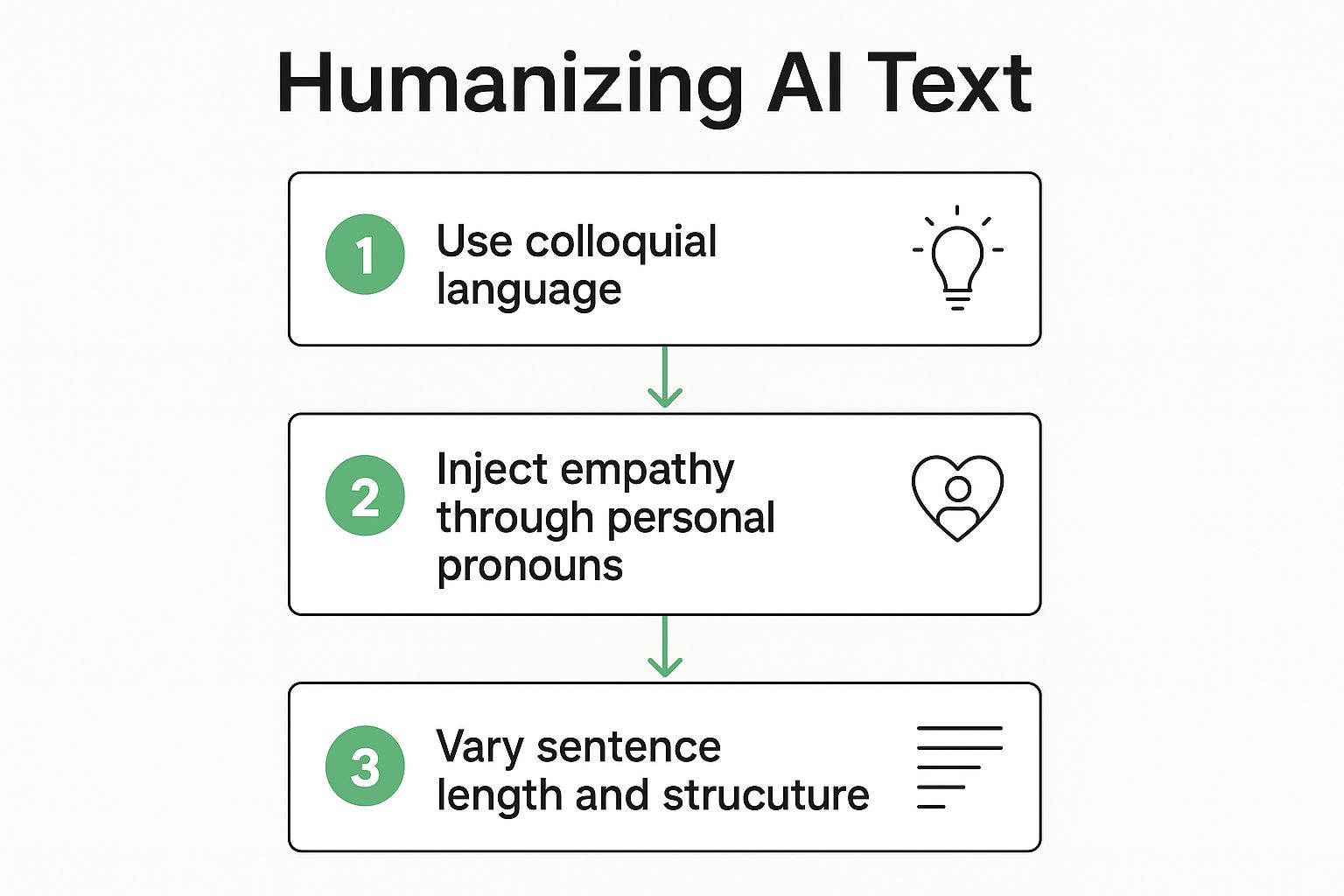
Humanize AI Text: Make Robotic Content Engaging & Natural
June 10, 2025
Understanding Why AI Text Feels Robotic (And What To Do About It)
AI writing tools are becoming increasingly sophisticated, generating large volumes of text rapidly. However, this speed and efficiency often sacrifice authenticity. AI-generated content can feel robotic and impersonal in its raw form. This disconnect stems from how AI creates text.
AI models learn by analyzing massive datasets of text and identifying patterns. They then use these patterns to predict the most statistically likely sequence of words for any given prompt. While impressive, this process often results in predictable and repetitive phrasing. For example, AI might overuse certain adverbs, adjectives, or sentence structures, creating a monotonous reading experience.
Additionally, AI struggles with nuanced language, often missing the subtle humor, sarcasm, or emotional undertones present in human communication. This makes the text feel flat and lacks personality.
The Limitations of Traditional AI Writing
Traditional AI writing often falls short because it lacks a genuine understanding of the topics it writes about. It can string words together grammatically but doesn't truly grasp the underlying meaning or context. This can result in factual inaccuracies, logical inconsistencies, and a lack of depth. For further insight, check out How to master humanizing AI text.
This means while AI can be a powerful tool for generating initial drafts or outlines, human intervention is crucial to bring the text to life. The quality of AI-generated content has improved significantly, with 84% of readers unable to distinguish between AI and human writing in blind tests. This improvement highlights AI's potential to help humanize content by making it more engaging and indistinguishable from human-generated work. Find more detailed statistics here.
However, this statistic also emphasizes the need for human editors to refine and polish the output. This ensures accuracy, clarity, and a natural, engaging tone.
Why Smart Businesses Prioritize Humanizing AI Content

Smart businesses know that simply generating text with AI isn't enough. They understand the importance of humanizing AI text to truly connect with their audience. This involves going beyond grammatically correct writing and focusing on content that resonates with human emotion and personality. This understanding is rooted in how content shapes customer perception and, ultimately, impacts business results.
The Hidden Costs of Robotic Content
Content that lacks a human touch can have serious consequences. One common issue is low engagement. When content feels robotic, readers are less likely to interact, share, or take any action. This can also weaken brand perception. If your content consistently feels impersonal, your brand might be seen as out of touch, damaging customer relationships.
These factors can contribute to lost conversions. If content fails to engage and persuade, it won't effectively drive sales or achieve desired results. Effective communication is key to building a successful business.
The Value of Authenticity in a Competitive Market
Authenticity is crucial in today's competitive business environment. Customers are discerning and easily recognize generic, robotic content. Humanizing AI text helps businesses build trust with their audience. This trust fosters loyalty and encourages long-term customer relationships.
This is especially important with the rise of AI content creation and a corresponding increase in skepticism. By 2025, it's estimated that over 82% of businesses will use AI writing tools, a significant jump from 45% in 2022. This growing reliance on AI makes humanization even more vital for differentiation. Find more statistics here.
Humanizing AI Text: A Competitive Advantage
Investing in humanizing AI content isn't just about improving quality; it's a strategic move for maintaining a competitive edge. Businesses that prioritize authentic communication build stronger audience connections. These connections lead to increased engagement, improved brand loyalty, and ultimately, greater business success.
This allows companies to maintain a human-centric approach. By humanizing their AI-generated content, businesses not only improve its effectiveness but also enhance their brand image and build lasting relationships with their customers.
Proven Techniques That Actually Humanize AI Text

This infographic illustrates a simple three-step process for making AI text sound more human: use everyday language, add empathy with personal pronouns, and mix up your sentence lengths and structures. These steps can transform robotic content into something relatable. Working in tandem, they create a natural rhythm and an empathetic tone that mimics how real people write. Want to learn more? Check out this helpful resource: How to master humanizing AI text.
Injecting Personality and Emotion
One effective way to humanize AI text is by injecting personality. This goes beyond just stating facts. It's about incorporating humor, anecdotes, and even personal opinions. For example, instead of the dry "Studies show that exercise is beneficial," try something more personal like, "I've found that even a short walk can totally boost my mood – and the research agrees!" This adds a relatable, human element.
Adding emotional triggers also helps. Think about the feelings you want to evoke in your readers—joy, excitement, maybe empathy—and choose your words accordingly. Descriptive language and sensory details can further strengthen the emotional connection.
Mastering Conversational Tone
A natural, conversational tone is key for humanizing AI text. This means avoiding overly formal language, complicated sentences, and technical jargon. Imagine chatting with a friend or colleague. That's the level of informality you should aim for in your writing. Think contractions, colloquialisms, and personal pronouns.
It's a balancing act, though. Avoid overly casual or slang-heavy language that might not suit your audience. The goal is approachable and natural, not sloppy or unprofessional. This balance keeps your writing accessible and engaging while maintaining a sense of authority.
Adding Depth and Detail
Humanizing AI text often means adding depth and detail. Go beyond surface-level descriptions. Provide specific examples, anecdotes, and supporting evidence. Imagine you’re painting a picture with your words.
Instead of simply stating a fact, illustrate it with a relatable story or a real-life scenario. For instance, instead of writing "Customer service is important," share a quick story about a great customer service experience you’ve personally had.
This not only makes your writing more engaging but also builds your credibility. By sharing examples and evidence, you build trust with your audience and position yourself as a knowledgeable source.
To illustrate these techniques further, let’s examine a comparison of various humanization methods. The following table highlights the effectiveness, difficulty, and best use cases for each technique.
| Technique | Effectiveness | Difficulty | Best Use Case | Time Investment |
|---|---|---|---|---|
| Using Colloquialisms and Contractions | High | Low | Blog posts, social media, informal emails | Low |
| Injecting Personal Anecdotes | Medium | Medium | Blog posts, articles, personal essays | Medium |
| Varying Sentence Structure | High | Low | All types of writing | Low |
| Incorporating Emotional Triggers | Medium | High | Marketing copy, storytelling, persuasive writing | Medium |
| Adding Depth and Detail with Examples | High | Medium | Articles, reports, educational content | Medium to High |
As you can see, some techniques are easier to implement than others, but all can contribute significantly to humanizing AI-generated content. Choosing the right combination depends on the specific context and your overall goals.
Advanced Strategies For Professional Content Teams

Professional content teams face a challenge: scaling content creation while keeping a human touch and consistent brand voice. This requires more than simple editing; it demands a strategic approach to AI text humanization. This involves implementing solid systems and training team members in advanced techniques. For a deeper dive into this topic, check out this helpful resource: How to Humanize Text from ChatGPT.
Building a Framework for Consistent Humanization
A crucial aspect of successful AI text humanization is a detailed style guide. This guide should define the brand's voice, including preferred tone, vocabulary, and sentence structure. This shared playbook ensures consistency across all content, regardless of the writer.
Investing in training for your team is also key. Workshops focused on recognizing and fixing robotic phrasing, adding personality to AI-generated content, and understanding the nuances of human communication can be incredibly valuable. This empowers team members to humanize AI text effectively while adhering to brand guidelines.
Adapting Humanization to Different Content Formats
Different content types require different humanization strategies. Technical documentation, for instance, benefits from clear, concise language, while marketing materials thrive on emotional connection and storytelling. Recognizing these differences is vital for preserving the effectiveness and purpose of each piece.
Teams should adapt their methods based on the content's goals. Technical content may prioritize clarity and accuracy, while creative content focuses on emotional resonance and brand storytelling. This flexible approach ensures humanization enhances, rather than detracts from, the content’s impact.
Implementing Quality Control and Efficient Workflows
High-performing teams build quality control into their workflows. This could involve peer reviews, dedicated editing stages, and using AI detection tools. These measures help ensure a human touch before publication, protecting brand reputation and building audience trust. The use of AI in content marketing is increasingly prevalent, from ideation (71%) to strategy (40%). Nearly two-thirds of marketing professionals use AI writing tools daily, striving for human-like quality. For more insights on this trend, see these AI writing statistics.
Streamlined workflows are also important. This might involve defining clear roles and responsibilities, using project management software like Asana, and automating repetitive tasks. These efficient processes allow teams to manage large volumes of content without sacrificing the human element that drives engagement. By focusing on both quality and efficiency, teams can leverage the power of AI while consistently delivering authentic, engaging content.
Essential Tools For Streamlining AI Text Humanization
Creating human-sounding AI text can be much easier with the right tools. Think of it like carpentry: you need the right tools to build something great. Similarly, content creators need specific software to refine AI-generated content. This section explores the essential tools for humanizing AI text, guiding you through the available options to find the best fit for your specific needs.
Understanding the Tool Landscape
The available tools generally fall into three categories: humanization software, editing platforms, and AI detection tools. Humanization software focuses specifically on making AI text sound more natural by changing phrasing and structure. Editing platforms offer a broader range of features, including grammar and style checks, and some even include plagiarism detection. Finally, AI detection tools help identify text that was likely generated by AI, pointing out areas that need that human touch.
The best tools for you depend on your particular situation. Consider factors like how many people are on your team, how much content you create, and your budget. For individuals or small teams, a free AI detection tool or budget-friendly humanization software might be sufficient. Larger organizations might benefit from more robust editing platforms designed for collaboration. Natural Write is a good example of a free web-based platform that transforms AI-generated text into natural-sounding language. It focuses on improving tone, clarity, and readability for various content types while also helping content bypass leading AI detection tools.
Choosing the Right Tools for Your Needs
To help you choose the right tools, we've compiled a comparison table. It details popular options and their features, so you can see which aligns best with your needs and budget.
To help you make an informed decision, the table below provides a comprehensive overview of several popular AI humanization tools. It outlines their key features, pricing structures, user ratings, and the scenarios they are best suited for.
| Tool Name | Key Features | Pricing | User Rating | Best For |
|---|---|---|---|---|
| Natural Write | One-click humanization, AI detection bypass, privacy-focused | Free | High | Individuals, small teams |
| QuillBot | Paraphrasing, grammar checking, plagiarism detection | Free and paid options | High | Students, writers |
| Grammarly | Grammar and style checker, tone detector, plagiarism detection | Free and paid options | High | Professionals, businesses |
| Wordtune | Rewriting, tone adjustment, fluency enhancer | Free and paid options | Medium | Content creators, marketers |
This comparison showcases the variety of tools available, reinforcing the importance of selecting the right solution based on individual needs. From free options like Natural Write to more feature-rich paid tools, there's a solution for everyone.
Optimization Strategies and Cost-Benefit Analysis
After choosing your tools, using them effectively is crucial for getting the most out of your investment. This means understanding what each platform does best and integrating it into your workflow. Some tools might be great at rephrasing, while others excel at adjusting tone and style.
A cost-benefit analysis is also important. Weigh the cost of each tool against the time you'll save and the improved quality of your content. This analysis helps justify the expense and ensures you're getting good value.
By carefully assessing your needs, exploring the available tools, and implementing optimization strategies, you can streamline your AI text humanization process. This frees you to focus on what really matters: creating compelling, human-quality content that engages your audience and achieves your goals.
Measuring Success And Future-Proofing Your Content Strategy

Humanizing AI-generated text is a continuous process. For ongoing improvement, it's essential to establish clear benchmarks to measure how effective your efforts are. Just as important is adapting your strategies to match the rapid pace of AI advancements.
Key Performance Indicators for Humanized Content
How can you tell if your efforts to humanize AI text are actually working? The key is tracking the right key performance indicators (KPIs). These metrics provide the data you need to assess the impact of your humanization strategies. Standard metrics like engagement (likes, shares, comments) and conversion rates offer valuable insights into audience interaction.
But humanizing AI text goes deeper than these basic metrics. Consider measuring reader satisfaction directly through surveys or feedback forms. Also, track changes in brand perception to see how humanized content influences your brand image. Together, these metrics provide a comprehensive view of your humanization success.
Setting Up a Testing Framework
A practical way to measure humanization effectiveness is through a testing framework. This involves comparing the performance of humanized AI content against content that hasn't been humanized. This A/B testing approach offers concrete data to demonstrate the value of humanization.
For instance, publish two versions of a blog post: one using raw AI-generated text, and another with a humanized version. By analyzing how each performs, you can gain specific insights into the benefits of humanization. This data-driven approach allows you to refine your strategies and maximize your return on investment.
Adapting to Evolving AI Capabilities
The field of generative AI is constantly changing. Projected to reach $62.72 billion by 2025, the market is expected to grow at a CAGR of 41.53% between 2025 and 2030, fueled by advancements in large language models. This rapid growth demands adaptable humanization processes. Learn more about these trends with these generative AI statistics and trends.
Staying up-to-date on emerging AI trends and industry developments is crucial. Understanding the evolving capabilities of AI allows you to anticipate necessary changes and adapt your humanization techniques. This proactive approach ensures your content remains effective and engaging as AI technology progresses.
Building a Sustainable Process
Future-proofing your content strategy means building a sustainable humanization process. This includes developing actionable frameworks for continuous improvement, implementing effective team training, and adopting strategic planning.
Regularly evaluate your processes, train your team on new techniques, and plan for future changes to maintain a competitive edge. By fostering a culture of continuous learning and adaptation, your content will remain authentic, engaging, and impactful, regardless of how technology evolves. This proactive approach safeguards your content strategy and keeps you ahead of the curve.
Key Takeaways And Your Action Plan
Humanizing AI-generated text isn't just a nice-to-have anymore; it's essential for anyone wanting to genuinely connect with their audience. By using the strategies we've discussed, you can transform robotic content into engaging, natural writing that resonates. This section provides a clear action plan for putting these techniques into practice.
Immediate Actions You Can Take Today
Begin by analyzing your existing content. Look for signs of AI-generated text, such as repetitive phrasing and a lack of emotional depth. Try incorporating some quick fixes:
Embrace the Power of "I": Using first-person pronouns adds personality and makes your writing more relatable.
Show, Don't Just Tell: Replace generic statements with specific examples and stories. This adds depth and makes your content more memorable.
Find Your Voice: Develop a conversational tone that reflects your brand's personality. Imagine you're speaking directly to your ideal reader.
These small changes can significantly improve how your audience perceives your content.
Building a Long-Term Humanization Strategy
For lasting improvement, create a long-term strategy that incorporates these best practices:
Develop a Style Guide: Create guidelines for your team to ensure consistent tone and voice across all your content.
Invest in Training: Help your team learn to recognize and correct robotic phrasing, injecting personality into AI-generated text.
Establish a Review Process: Set up a quality control system to catch and fix any robotic phrasing before publishing.
This structured approach will help you maintain consistency and scale your humanization efforts more effectively.
Measuring Your Success
Track key metrics like engagement, conversion rates, and reader satisfaction. A/B testing, comparing humanized and non-humanized content, provides data-driven insights for refining your approach.
| Metric | Target | Measurement Method |
|---|---|---|
| Engagement | Increased likes, shares, comments | Social media analytics, website analytics |
| Conversion Rates | Improved click-through rates, lead generation | Marketing platform analytics |
| Reader Satisfaction | Positive feedback, increased time on page | Surveys, website analytics |
This data will demonstrate the impact of humanization on your content's performance.
Transform Your Content With Natural Write
Ready to improve your humanization process and create compelling content that truly connects with your audience? Natural Write, a free web-based platform, transforms AI-generated text into natural-sounding language while also bypassing leading AI detection tools. Improve tone, clarity, and readability across various content types while preserving your core ideas. Visit Natural Write and see the difference.


